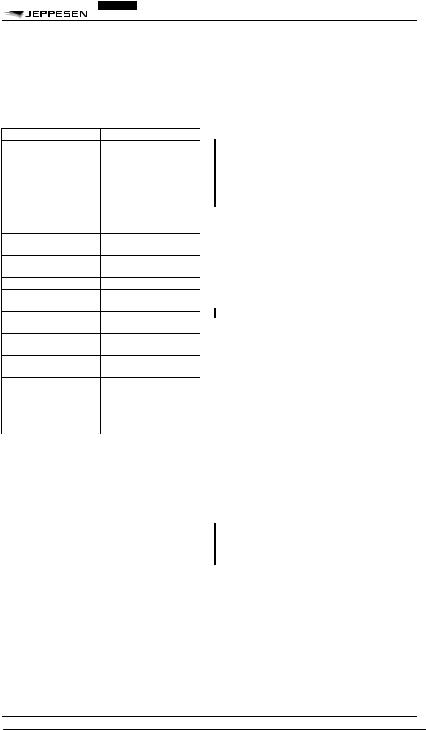
AIR TRAFFIC CONTROL
.pdf
20 NOV 09 AIR TRAFFIC CONTROL |
PORTUGAL-1 |
PORTUGAL - RULES AND PROCEDURES
The following information also refers to Madeira Is.
GENERAL
In general, the air traffic rules and procedures in force and the organization of the air traffic services are in conformity with ICAO Standards, Recommended Practices and Procedures.
Units of measurement used in connection with all air traffic services in Portugal:
1Alternative unit
WGS-84 IMPLEMENTATION STATUS
WGS-84 compliant.
FLIGHT PROCEDURES
HOLDING
Holding procedures comply with Jeppesen ATC-Chapter “Flight Procedures (DOC 8168) - Holding procedures”, Table IV-1-1, Holding Speeds.
PROCEDURE LIMITATIONS AND OPTIONS
Instrument approach procedures for civil airports comply with PANS-OPS, Document 8168, Volume II, 4th Edition. Instrument approach procedures for military aerodromes are based on the United States Standards for Terminal Procedures (TERPS).
AIRPORT OPERATING MINIMUMS
Portugal publishes OCA(H)s for civil airports and DA/MDA, ceiling and visibilities for military aerodromes.
Jeppesen charted minimums are not below State minimums.
NOISE ABATEMENT PROCEDURES
The following procedures may at any time be departed from to the extent necessary for avoiding immediate danger. Every operator of aircraft using the airport, shall ensure at all times that aircraft are operated in a manner calculated to cause the least disturbance practicable in areas surrounding the airport.
Departures: For aircraft licensed in accordance with ICAO ANNEX 16, Chapter 2, Noise Abatement Procedure NADP A is required.
For aircraft licensed in accordance with ICAO ANNEX 16, Chapter 3 as well as B737-200 as far as the noise levels for take-off pursuant to ICAO ANNEX 16, Chapter 3 have provably been reached by supplementary equipment, Noise Abatement Procedure NADP B is required.
For details about NADP A & B refer to ATC Chapter “Flight Procedures (DOC 8168) Appendix to Chapter 3 - Noise Abatement”.
Aeroplanes such as supersonic aeroplanes not using wing flaps for take-off should reduce thrust before attaining 1000ft but not lower than 500ft.
ATS AIRSPACE CLASSIFICATIONS
Portugal has adopted the ICAO ATS airspace classification as listed in ATC-Chapter “ICAO ATS Airspace Classifications-Annex 11”.
Within Lisbon FIR/UIR the airspace is classified “C”, “D” and “G”.
Within Santa Maria Oceanic FIR the airspace is classified “A”, “C” and “G”.
The airspace classification “D” has been allocated to the restricted areas LPR60A/60B/42A/42B/51A/ 51BN/51BS while these airspace volumes are affected to military use. When these airspace volumes are available for GAT use its classification will change to “C”. Within class “G” airspace at and below 3000ft AMSL and clear of cloud and in sight of the surface helicopters may be operated when their speed, having regard to the visibility, is reasonable.
VFR flights shall not be operated above FL200 in airspace class “C” at transonic and supersonic speeds.
SPECIAL REQUIREMENTS AND REGULATIONS
FLIGHT PLANNING
For flights intending to operate within the North Atlantic MNPS airspace during any portion of their flight the letter ’X’ shall be inserted in item 10 of the ICAO FPL after the letter ’S’ to clearly indicate that the aircraft is capable of complying with MNPS.
© JEPPESEN, 1989, 2009. ALL RIGHTS RESERVED.

PORTUGAL-2 |
AIR TRAFFIC CONTROL 20 NOV 09 |
|
PORTUGAL - RULES AND PROCEDURES |
For flights intending to operate within the North Atlantic MNPS airspace between FL290 and 410 inclusive, during any portion of their flight the letter ‘W’ shall be inserted in item 10 of the ICAO FPL after the letters ‘S’ and ‘X’ to clearly indicate that the aircraft has received State approval for RVSM operations.
NOTE: Aircraft without State approval for RVSM operations shall not be allowed to operate within MNPS airspace, where Reduced Vertical Separation is being applied.
Flights intending to leave RVSM airspace shall flight plan to leave the designated area at a conventional (NON RVSM) flight level.
All Flightdata concerning MIL ACFT flying from, to or overflying Portugal (Mainland) must be addressed to LPAMYWYB, MIL INFO Center and also to LPPTYWYB and LPAMYWYA.
East or westbound flights crossing Lisbon FIR/UIR boundary south of ‘SGR’ VORDME must include point ‘SONAP’ in their flight plan.
North or southbound flights along 010°W via ‘ORTOP’ must also include ‘SONAP’ in their flight plan as the turning point and ‘XERES’ as entering/exit point.
IFPS/CFMU OPERATIONS General
The Integrated Initial Flight Plan Processing System element of the EUROCONTROL Central Flow Management Unit (CFMU) is the sole source for the distribution of the IFR/General Air Traffic (GAT) FPL and associated messages to ATS units within the IFPS. The only required addresses are those of the two IFPS Units (IFPU) at Haren (Brussels) and Bretigny (Paris).
Flight Plan Message Addressing
 AFTN: EUCHZMFP and EUCBZMFP SITA: BRUEP7X and PAREP7X
AFTN: EUCHZMFP and EUCBZMFP SITA: BRUEP7X and PAREP7X
For complete details on the IFPS and CFMU procedures, refer to the Eurocontrol CFMU manuals or to the Jeppesen European Air Traffic Flow and Capacity Management (EATFCM) User Guide.
Differences from CFMU Standard Procedures
During closure hours of Ponta Delgada ARO, flight plans and associated messages concerning Santa Maria FIR should be addressed to Lisbon ARO (LPPTZPZX).
IFR/GAT authorized flights with destination (Military) transit Aerodrome NR 1 (AT1) located at Lisbon Int’l Airport (LPPT) must include on line AD (RE-ADDRESSING FUNCTION OF IFPS) of the FPL and associates messages the following location indicator: LPPTYXYA.
OCEANIC CLEARANCES
All flights entering the NAT region through Santa Maria Oceanic Control Area must obtain ATC clearance before crossing the Oceanic Control Area.
Pilots should always endeavor to obtain Oceanic Clearance prior to entering Santa Maria Control Area; however if any difficulty is encountered the pilot should not hold while awaiting Clearance unless so directed by ATC.
Requests for Oceanic Clearances
All operators should request their Oceanic Clearance from Santa Maria OACC, through Santa Maria Radio, on appropriate HF frequencies or VHF 132.075MHz at least 40 minutes before the ETO for the NAT boundary. Those flights which use data link services for Oceanic Clearance Request and reception, must establish voice contact with Santa Maria Radio for SELCAL check on appropriate HF frequencies or on VHF 132.075MHZ prior entering Santa Maria FIR. Departures from aerodromes situated close to the NAT region boundary shall request Oceanic Clearance as soon as possible after departure. Flights from Lisbon FIR shall inform Lisbon ACC of the flight level and entry point in the NAT region, contained in the Oceanic Clearance.
Operators departing from Azores should request their Oceanic Clearance from Santa Maria OACC, through Santa Maria Radio, on appropriate HF frequencies or on VHF 127.900MHz 20 minutes before estimated departure from Azores. Pilots shall inform Santa Maria OACC through Santa Maria Radio whenever the ETD has a time difference from the previously given ETD of more than 6 minutes.
All flights shall carefully monitor the estimate for the OCA entry point as non-compliance may result in a re-clearance to a less economical flight profile.
Oceanic clearances delivery for NAT tracks
Santa Maria ACC will issue Oceanic Clearance for aircraft flying on NAT tracks using the track letter, flight level and Mach number, without the current NAT Track message identification number.
Pilots are expected to include the NAT track Message identification number in the read back of the Oceanic Clearance.
If the Track message Identification number is included on the read back there is no requirement for the pilot to read back the NAT Track coordinates.
If any doubts exist to the Track Message identification number or the NAT Track coordinates the pilot should request the full Track coordinates.
Similarly, if the pilot cannot correctly identify the Track Message Identification number, Santa Maria will read the cleared NAT Track coordinates in full and request a full read back of these coordinates.
The Oceanic Clearance may be issued beyond NAT Track limit and may include ATS route designators.
When ATS route designators are included as part of the Oceanic Clearance, there is no requirement for the pilot to read back the significant points make up the ATS route.
© JEPPESEN, 1989, 2009. ALL RIGHTS RESERVED.

23 APR 10 AIR TRAFFIC CONTROL |
PORTUGAL-3 |
PORTUGAL - RULES AND PROCEDURES |
|
Oceanic clearances delivery for all other routes
Santa Maria ACC will issue an Oceanic Clearance for aircraft flying on random routes, specifying the full route details, flight level and Mach number.
Flights that operate partially along a published NAT Track are considered as random routes.
ATS route designators may be included as part of the Oceanic Clearance as received although when ATS route designators are included as part of the Oceanic Clearance, there is no requirement for the pilot to read back the significant points that make up the ATS route.
NAT ORGANIZED TRACK SYSTEM
Iberian Peninsula Organized Track Structure
The eastern anchor points of the Iberian Peninsula Organized Tracks are Santiago ’STG’ VORDME and/or DIRMA and/or BUSEN.
Tracks may be established using one, two or three of these anchor points. Alternatively main tracks may be tied to Santiago ’STG’ VORDME or Espichel ’ESP’ VORDME with a tributary track from DIRMA joining one of the main tracks at the eastern boundary of the Santa Maria Oceanic FIR.
Even on occasions when no tributary track from DIRMA has been promulgated, pilots may plan the flight via DIRMA to join a promulgated track at the Oceanic boundary.
Information required from operators
All operators conducting flight operations in the Santa Maria Oceanic FIR, North of 37 N, shall provide information to the Santa Maria Oceanic Area Control Centre regarding the tracks likely to be requested by turbo-jet aircraft during the peak traffic periods.
The westbound peak traffic information, if received by Santa Maria OAC not later than 2330 UTC, shall be taken into consideration when determining the eventual necessity of implementing Day Organized Tracks and establishing its coordinates through the NAT Regions.
For all flights in Santa Maria Oceanic FIR it is mandatory to report wake turbulence problems when using RVSM flight levels.
Flight planning
For flights conducted along one of the Organized Tracks from the entry point into the NAT Flight Information Regions to the exit point, the Organized Track shall be defined in the Flight Plan by the abbreviation "NAT" followed by the code letter assigned to the track.
For flights conducted along one of the Organized Tracks from the entry point into the NAT flight Information Regions to the exit point, the estimated time of arrival only over the first Oceanic FIR boundary shall be specified in the item 18 of the Flight Plan.
For turbo-jet aircraft operating in the OTS the Mach number planned to be used shall be specified in the item 15 of the Flight Plan.
CARIBBEAN-EUROPEAN ROUTES
Flight Planning
Flights to/from/over the NE-bound between 0100 and 0800 UTC or SW-bound between 1100 and 1800 are recommended to file the defined routes (Organized Track System). Under special circumstances flights planning random routes will be accepted with prior coordination with the ACC units west of 40°W.
Random flight planning during other hours is acceptable.
Flexible E-bound/W-bound CAR/EUR track
When required, a flexible E-bound/W-bound CAR/EUR track will be established.
Details of the flexible track will be published in the NAT OTS daily night track message originated by Gander OAC.
NAT operators and ATS units serving such flights which are not yet receiving the Gander OTS track message should request to be included in the distribution list to AFTN address CZQXZQZX.
Flights originated in the CAR region or beyond and bound for Europe, estimating meridian 30W between 0100 and 0800 UTC, are requested to plan their flight via the published track. It should be noted that the FL stated for use on this track is included for planning purposes only. However, actual flight levels for each individual flight will be assigned after appropriate coordination between the OAC’s concerned.
STRATEGIC LATERAL OFFSET PROCEDURES (SLOP)
The Strategic Lateral Offset Procedure (SLOP) is now a Standard Operating Procedure throughout the North Atlantic (NAT) Region. Pilots conducting oceanic flight within the NAT Region with automatic offset programming capability are recommended to fly lateral offsets of either 1 or 2 NM of centre line
DATA LINK SERVICES WITHIN SANTA MARIA FIR
Various Air Traffic Services (ATS) Data Link services are available in the Santa Maria Oceanic Control Area (OAC). These services include Flight Management Computer Waypoint Position Reporting (FMC WPR), Automatic Dependent Surveillance Waypoint Position Reporting (ADS WPR), Controller Pilot Data Link Communications (CPDLC) and Oceanic Clearance Delivery (OCD).
© JEPPESEN, 1989, 2010. ALL RIGHTS RESERVED.

PORTUGAL-4 |
AIR TRAFFIC CONTROL 23 APR 10 |
|
PORTUGAL - RULES AND PROCEDURES |
General Procedures
In the first contact with Santa Maria Radio Station, pilots must state the Data Link service they are using (FMC, ADS or CPDLC) and the next FIR they are transiting into. The frequency instructions for the next FIR may be issued by Santa Maria Radio on the first contact or later on via voice or data link. Pilots using ADS WPR or FMC WPR are exempted from voice position reporting procedures, unless specifically requested by ATC. FMC WPR and ADS WPR flights are also exempted from all routine voice meteorological reporting. Reports of unusual meteorological conditions such as severe turbulence, thunderstorms, etc., are to be made by voice to Santa Maria Radio. CPDLC should not be used for meteorological reports unless voice contact cannot be established. Flight crews should not ask Santa Maria Radio questions regarding the data link services status, or whether a downlink message has been received. Should Santa Maria OAC fail to receive an expected FMC or ADS WPR, a voice report will be requested.
Further details on data link services: Guidance Material for ATS Data Link Services in North Atlantic Airspace, available at www.paris.icao.int
Santa Maria FIR address for Datalink Services
To establish contact with Santa Maria FIR through Datalink Services (CPDLC, ADS and OCD) pilots must use the ICAO four letter designator LPPO.
Safety related issues
The use of data link services does never exempt the crew from establishing voice contact with Santa Maria Radio at or before the FIR Boundary, whether on HF or VHF, even if they are in possession of a valid Oceanic Clearance and/or with a CPDLC connection established. Pilots using a CPDLC connection must be aware that any clearance request via data link may be answered via voice and also that a clearance requested via voice, may be answered via data link. If due to this mixed data link/voice communications environment any doubt arises, special care must be taken before initiating any route, level or speed profile change, confirming first with ATC.
RESTRICTIONS TO NOCTURNAL FLIGHTS FOR CIVIL AIRCRAFT ON PORTUGUESE AIRPORTS
On Airports and/or Aerodromes landing and/or takeoff is forbidden between 0000 and 0600 LT, except in case of force majeure.
However, according to Governmental deliberation an exception regime has been granted for Lisbon, Porto and Madeira Airports in which landing and/or take-off are allowed in a limited number. Thus, in these Airports landing and/or take-off will be allowed between 0000 and 0600 LT to civil aircraft that:
–have had a flight coordinated with at least one day in advance with the IATA Airport Slot Coordinator, and
–have a noise certificate according with ICAO Annex 16, Vol I, Chapt 3.
Cases of force majeure are considered as follows:
–aircraft and medical emergencies, evacuations and humanitarian reasons,
–landing and take-off in a situation where the airport is alternate for meteorological reasons, technical failure or flight safety,
–flights that have been previously approved by the Government or occasionally by Portuguese National Aviation Institute - INAC, in cases which proved of public interest,
–flight delays caused by serious Air Traffic Control perturbation,
–landing and/or take-off until 0100 LT for flights planned before 0000 LT delayed for reasons not imputable to aircraft operator or airport,
–traffic portion to/from Autonomous Regions of Madeira and Azores, due to meteorological reasons,
–landings in the period from 0500 to 0600 LT due to meteorological reasons, provided the scheduled arrival time is planned after 0600 LT.
These restrictions do not apply to Military flights, landing and/or take-off by reasons of force majeure are not accountable for maximum limit of movements between 0000 and 0600 LT referenced above.
ACAS II/TCAS II REQUIREMENTS
Civil fixed wing turbine-engined aircraft exceeding 5700kg, or a maximum approved passenger seating configuration of more than 19, are required to be equipped with, and operate ACAS II.
RADAR PROCEDURE WITHIN LISBON, PORTO, FARO AND MADEIRA TMA’S
Within LISBON FIR TMAs, unless otherwise advised by ATC, speed adjustment under Radar Control on Arrivals to Alverca (LPAR), Cascais (LPCS), Faro (LPFR), Lisbon (LPPT), Madeira (LPMA), Montijo (LPMT), Porto (LPPR) and Porto Santo (LPPS) shall be in accordance with the following:
a.Maximum IAS 280KT between FL245 and FL100
b.Maximum IAS 250KT at and below FL100
c.Maximum IAS 220KT at and below FL070
d.Maximum IAS 200KT at and below 4000FT
e.Maximum IAS between 180KT and 160KT when established on the final approach segment and thereafter 160KT until 4NM from threshold
Additionally, ATC may request specific speeds for accurate spaces. Pilots are requested to comply with speed adjustments as promptly as feasible within their own operational constraints, advising ATC if circumstances necessitate a change of speed for aircraft performance reasons.
© JEPPESEN, 1989, 2010. ALL RIGHTS RESERVED.

23 APR 10 AIR TRAFFIC CONTROL |
PORTUGAL-5 |
PORTUGAL - RULES AND PROCEDURES |
|
FREE ROUTE AIRSPACE WITHIN LISBON FIR/UIR (FRAL) ABOVE FL245
Within FRAL airspace users will be able to plan userpreferred trajectories by use of 5 letter waypoints and radio navigation aids. Route portions between waypoints will be indicated by means of “DCT” instruction. Traffic will be subject to rules, procedures and Letters of Agreement. Within the FRAL area there will be no limitations on the use of “DCT”. Overflight traffic should plan directly from Lisbon FIR/UIR entry point to Lisbon FIR/UIR exit point. Entry traffic should plan directly from Lisbon FIR/UIR entry point to the STAR initial waypoint. Exit traffic should plan directly from the SID final waypoint to the Lisbon FIR/UIR exit point.
Cross-Border-DCT-NOT allowed, with the exception of the segments mentioned below. Following IFPS procedures, DCT segment which ends in the FIR but starts in another FIR which is not part of the same national airspace is NOT permitted. Airspace users will have to plan their trajectory inside Free Route Airspace in Lisbon FIR by use of intermediate waypoints.
DIFFERENCES FROM ICAO STANDARDS AND PROCEDURES
ICAO REFERENCE
ANNEX 2
3.3.1.2 In addition to ICAO provisions the submission of a flight plan is required for all VFR flights within controlled airspace of Lisbon FIR.
APPENDIX 3
Following differences with regard of track are applied:
a.“from 090 degrees to 269 degrees” instead of “from 000 degrees to 179 degrees”.
b.“from 270 degrees to 089 degrees” instead of “from 180 degrees to 359 degrees”.
Exceptional Cross Border DCT segments allowed are:
–RALUS-DCT-ALAGU
–RALUS-DCT-AMSEL
–BABEX-DCT-ALAGU
–BABEX-DCT-AMSEL
–BABEX-DCT-OSLAD
For speed and level changes inside FRAL, on FPL item 15, additionally to a waypoint or navaid and only for this purpose, operators may also use LAT/LONG coordinates. In terms of flight planning, item 15, flight levels within FRAL will respect the table of cruising levels (see differences from ICAO Standards), with the exception of waypoint RIVRO. By letter of agreement, traffic intending to enter Lisbon FIR via RIVRO must enter in odd flight levels and traffic intending exit Lisbon FIR via RIVRO must exit in even flight levels.
AO’s will plan their trajectory inside FRAL disregarding all segregated airspace. In case there is no availability to cross segregated areas, it is expected that the average route extension to be considered by aircraft operators is approximately 5NM, however, in most cases, radar vectors shall be provided by ATC. In case of contingency a reduced ATS route structure above FL245 will apply. Further information can be obtained from:
NAV Portugal E.P.E.
DSEGOP/ESAPRO
Address: Edificio 118 Aeroporto de Lisboa Lisbon
Portugal 1700–007
E-Mail: jesus.conde@nav.pt
© JEPPESEN, 1989, 2010. ALL RIGHTS RESERVED.

30 JAN 09 AIR TRAFFIC CONTROL |
SERBIA-1 |
SERBIA - RULES AND PROCEDURES
GENERAL
In general, the air traffic rules and procedures in force and the organization of the air traffic services are in conformity with ICAO Standards, Recommended Practices and Procedures.
Units of measurement used in connection with all air traffic services in Serbia:
WGS-84 IMPLEMENTATION STATUS
WGS-84 compliant.
FLIGHT PROCEDURES
HOLDING
Holding procedures comply with ATC-Chapter “Flight Procedures (DOC 8168) Part IV. Holding Procedures”, table “Holding Speeds ICAO DOC 8168”.
PROCEDURE LIMITATIONS AND OPTIONS
Instrument approach procedures comply with new PANS-OPS, Document 8168, Volume II.
AIRPORT OPERATING MINIMUMS
Serbia does not publish State airport operating minimums, except for Belgrade (Nikola Tesla) ILS approaches.
Serbia publishes Obstacle Clearance Altitudes (Heights) OCA(H).
Jeppesen charted minimums are not below State minimums.
ATS AIRSPACE CLASSIFICATIONS
Serbia has adopted the ICAO ATS airspace classification as listed on ATC-Chapter “ICAO ATS Airspace Classification - Annex 11”.
Within Belgrad FIR/UIR the airspace between FL195 and FL660 is classified as airspace “C”. Other part of the airspace remains unclassified.
SPECIAL REQUIREMENTS AND REGULATIONS
POSITION REPORTING PROCEDURE
For flights across the Serbia entry/exit corridors position reports are mandatory. Reporting of overflight of all compulsory reporting and transfer points on airways and VFR air corridors is mandatory unless otherwise requested by the competent ATS unit.
Position reports shall contain the following data:
–aircraft identification,
–aerodrome of destination,
–position and time,
–flight level.
REQUIRED NAVIGATION PERFORMANCE
Aircraft, other than state aircraft, operating on the ATS routes within Belgrad FIR/UIR under IFR shall be equipped with, as a minimum, RNAV equipment meeting RNP 5.
Carriage of RNP 5 RNAV equipment is not required on lower ATS routes between minimum flight altitude and FL145.
SPECIAL VFR FLIGHTS
On request of the pilot-in-command, an air traffic clearance may be granted for VFR flight within a control zone if ground visibility is at least 8km and distance from clouds at least 2km horizontally, and 300m (1000 ft) vertically. Air traffic clearance for such a flight may be granted only if traffic conditions in control zone permit, and on condition that pilot-in-command remains responsible for maintaining separation from other aircraft and obstacles.
ATC may authorize a visual flight to operate by day within the control zone to a general aviation aircraft (maximum allowed take-off mass up to 5700kg) if horizontal visibility is greater than 1500 m. Such a flight is designated as special VFR flight (SVFR).
VFR AT NIGHT
Visual flights within aerodrome traffic zone at night may be conducted if the pilot-in-command and the aircraft are capable of conducting such a flight and if the aerodrome fulfills conditions for night operations.
Visual flights from para above may be conducted if the following conditions are fulfilled: horizontal visibility is at least 8000m; pilot has continuous visual contact to the ground; the approach lights, threshold lights, runway lights and obstacle lights may be identified from the edge of aerodrome traffic zone and on condition that not more than two aircraft conduct a flight within that zone.
ACAS II/TCAS II REQUIREMENTS
Civil fixed wing turbine-engined aircraft exceeding 5700kg, or a maximum approved passenger seating configuration of more than 19, are required to be equipped with, and operate ACAS II.
© JEPPESEN, 2009. ALL RIGHTS RESERVED.

SERBIA-2 |
AIR TRAFFIC CONTROL 30 JAN 09 |
|
SERBIA - RULES AND PROCEDURES |
ACAS II/TCAS II Operators with ACAS II temporary u/s in accordance with Minimum Equipment List (MEL) do not require an exemption.
IFPS/CFMU OPERATIONS
General
The Integrated Initial Flight Plan Processing System element of the Eurocontrol Central Flow Management Unit (CFMU) is the sole source for the distribution of the IFR General Air Traffic (GAT) FPL and associated messages to ATS units within the IFPS.
The only required addresses are those of the two IFPS Units (IFPU) at Haren (Brussels) and Bretigny (Paris).
Flight Plan Message Addressing
 AFTN: EUCHZMFP and EUCBZMFP SITA: BRUEP7X and PAREP7X
AFTN: EUCHZMFP and EUCBZMFP SITA: BRUEP7X and PAREP7X
Repetitive Flight Plans (RPL)
Aircraft Operators are reminded that RPL data is to be addressed to:
CFMU
RPL Section
Address: Rue de la Fusee 96 Brussels
B-1130
in parallel with their normal submissions, as required, and to National Authorities.
For complete details on the IFPS and CFMU procedures, refer to the Eurocontrol CFMU manuals or to the Jeppesen European Air Traffic Flow and Capacity Management (EATFCM) User Guide.
VISUAL METEOROLOGICAL CONDITIONS
Except for special VFR flights within control zones, VFR flight shall be conducted so that the aircraft is flown in conditions of visibility and distance from clouds equal to or greater than those specified in table below:
Above 450m GND and
DIFFERENCES FROM ICAO
STANDARDS AND PROCEDURES
ICAO REFERENCE
ANNEX 2
No differences published.
© JEPPESEN, 2009. ALL RIGHTS RESERVED.

Eff |
AIR TRAFFIC CONTROL |
SLOVENIA-1 |
17 SEP 10 |
SLOVENIA - RULES AND PROCEDURES
GENERAL
In general, the air traffic rules and procedures in force and the organization of the air traffic services are in conformity with ICAO Standards, Recommended Practices and Procedures.
Units of measurement used in connection with all air traffic services in Slovenia:
WGS-84 IMPLEMENTATION STATUS
WGS-84 compliant.
FLIGHT PROCEDURES
HOLDING
Holding procedures comply with Jeppesen ATC-Chapter “Flight Procedures (DOC 8168) - Holding Procedures”, Table IV-1-1, Holding Speeds.
PROCEDURE LIMITATIONS AND OPTIONS
Instrument approach procedures comply with new PANS-OPS, Document 8168, Volume II.
AIRPORT OPERATING MINIMUMS
OCA(H)s are published together with DA(H)/MDA(H), and visibilities for landing and for take-off.
Jeppesen charted minimums are not below State minimums.
ATS AIRSPACE CLASSIFICATIONS
Slovenia has adopted the ICAO ATS airspace classification as listed on ATC-Chapter “ICAO ATS Airspace Classifications – Annex 11”.
Within Ljubljana FIR, however, only the airspace classes “C,” “D,” “E” and “G” are used.
In addition to ICAO provisions, separation is provided within Ljubljana, Maribor and Portoroz CTRs (class “D” airspace) between VFR and IFR flights.
IFR traffic within Class “C” airspace limited to maximum IAS 250KT below FL100, exemptions for military aircraft.
Within class “G” airspace at or below 900m (3000ft) MSL or 300m (1000ft) GND, whichever is higher, a flight visibility of 1.5Km is permitted. Helicopters may operate in a flight visibility of less than 1.5Km, if maneuvered at a speed that will give adequate opportunity to observe other traffic or any obstacles in time to avoid collision.
SPECIAL REQUIREMENTS AND REGULATIONS
FLIGHT PLANNING
All international flights within Schengen area departing from public registered national airports, shall submit appropriate flight plan at least one hour before the flight to:
ARO LJUBLJANA (ARO LJLJ)
Tel: |
+386 |
4 5951 430/431 |
Fax: |
+386 |
4 2023 851 |
AFS: |
LJLJZPZX |
|
Air Traffic Flow Management (ATFM)
The Integrated Initial Flight Plan Processing System element of the EUROCONTROL Central Flow Management Unit (CFMU) is the sole source for the distribution of the IFR General Air Traffic (GAT) FPL and associated messages to ATS units within the IFPS. The only required addresses are those of the two IFPS Units (IFPU) at Haren (Brussels) and Bretigny (Paris).
Flight Plan Message Addressing
AFTN: EUCHZMFP and EUCBZMFP SITA: BRUEP7X and PAREP7X
For complete details on the IFPS and CFMU procedures, refer to the Eurocontrol CFMU manuals or to the Jeppesen European Air Traffic Flow and Capacity Management (EATFCM) User Guide.
ACAS II/TCAS II REQUIREMENTS
Any operator flying within airspace of the ECAC member states shall be equipped with an ACAS II/TCAS II.
DIFFERENCES FROM ICAO STANDARDS AND PROCEDURES
ICAO REFERENCE ANNEX 2
3.3.1.2 |
Additionally, flight plans required for all |
IFR flights. |
|
Flight plans are also required for any VFR flight:
–departing from or arriving at an aerodrome within a CTR;
© JEPPESEN, 1989, 2010. ALL RIGHTS RESERVED.

SLOVENIA-2 |
AIR TRAFFIC CONTROL |
Ef |
17 SEP 10 |
SLOVENIA - RULES AND PROCEDURES
–crossing the Ljubljana TMA/CTR, Maribor TMA/CTR or Portoroz TMA/CTR.
–across the FIR boundary, i.e. international flights.
© JEPPESEN, 1989, 2010. ALL RIGHTS RESERVED.

28 AUG 09 AIR TRAFFIC CONTROL |
SPAIN-1 |
SPAIN - RULES AND PROCEDURES
GENERAL
In general, the air traffic rules and procedures in force and the organization of the air traffic services are in conformity with ICAO Standards, Recommended Practices and Procedures.
Units of measurement used in connection with all air traffic services in Spain:
WGS-84 IMPLEMENTATION STATUS
WGS-84 compliant.
FLIGHT PROCEDURES
HOLDING
Holding procedures comply with ATC-Chapter Part IV. Holding Procedures, table ‘Holding Speeds ICAO DOC 8168’.
AIRPORT OPERATING MINIMUMS
Spain publishes OCA(H)s.
Jeppesen charted minimums are not below State minimums.
ATS AIRSPACE CLASSIFICATIONS
Spain has adopted the ICAO airspace classification as listed in ATC-Chapter ‘ICAO ATS Airspace Classifications - Annex 11’.
SPECIAL REQUIREMENTS AND REGULATIONS
AIRCRAFT CLASSIFICATION DUE TO WAKE TURBULENCE
The separation minima due to wake turbulence are based on the aircraft classification depending on their MTOW.
HEAVY (H) |
136000kg or more |
MEDIUM (M) |
less than 136000kg and |
|
more than 7000kg |
LIGHT (L) |
equal or less than 7000kg |
B-757 and B-737 (737-800/900) must be considered as:
–HEAVY when being followed by another aircraft, and
–MEDIUM when they follow another aircraft
Wake Turbulence Separation between Arrivals and Departures
–Every pilot or aircraft operator which considers that its takeoff run could be lower than 300m, shall communicate so to the TWR controller (through the appropriate radio frequency).
–TWR controller will establish a wake turbulence separation of 2 minutes to the departure of an aircraft with a takeoff run lower than 300m, when following the arrival of a MEDIUM or HEAVY category aircraft.
GLOBAL POSITIONING SYSTEM (GPS) OPERATIONS
General
GPS may be used as both primary means of navigation and as a supplemental navigation system only after receipt of both airworthiness and operational approval from the Direccion General de Aviacion Civil or the aeronautical authority in the State of registry. Airworthiness shall be based on compliance with FAA TSO-C129 and FAA Notice 8110.60.
Flight Plan Information
Flight plans for operations oceanic/remote areas must include the entries “NAV/GPS” and “RMK/FDE AVAILABLE” in item 18. RPLs should include “NAV/GPS” in item Q if GPS navigation equipment is available on the aircraft.
GPS Usage
a.GPS may be used as a primary (sole) means of navigation in oceanic/remote areas subject to the following operational conditions:
1.Integrity provided by RAIM: GPS may replace one of the two required means of navigation.
2.Integrity not provided by RAIM:
–ground-based aids on the route to be flown must be available;
–aircraft equipment, other than GPS, suitable for the route to be flown must be available;
–integrity monitoring equivalent to RAIM must be performed by the navigation system.
NOTE: The appropriate Fault Detection and Exclusion (FDE) availability prediction program must be utilized no more than 2 hours prior to departure to determine the maximum duration of possible GPS outage due to the following:
– loss of navigation capability;
© JEPPESEN, 1989, 2009. ALL RIGHTS RESERVED.
